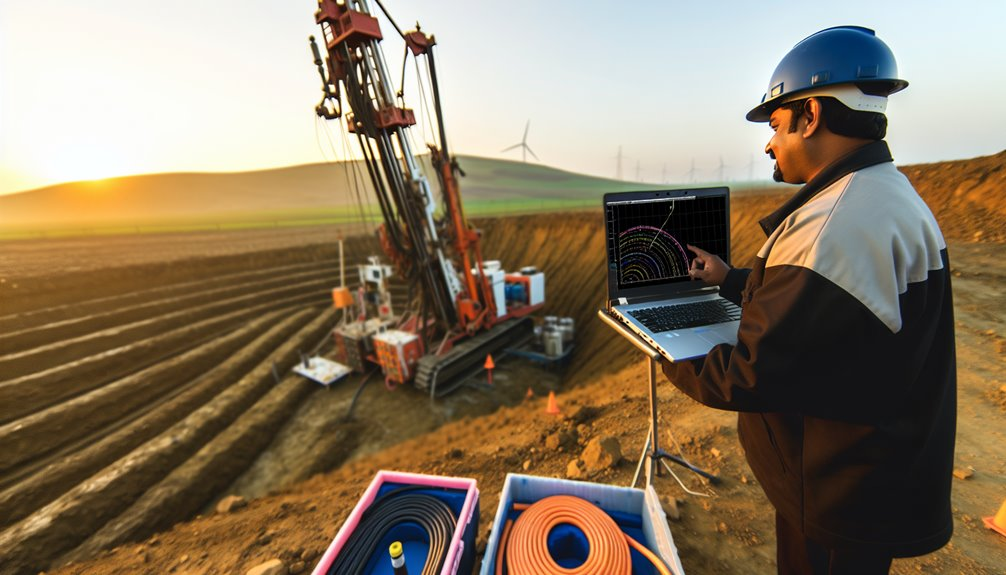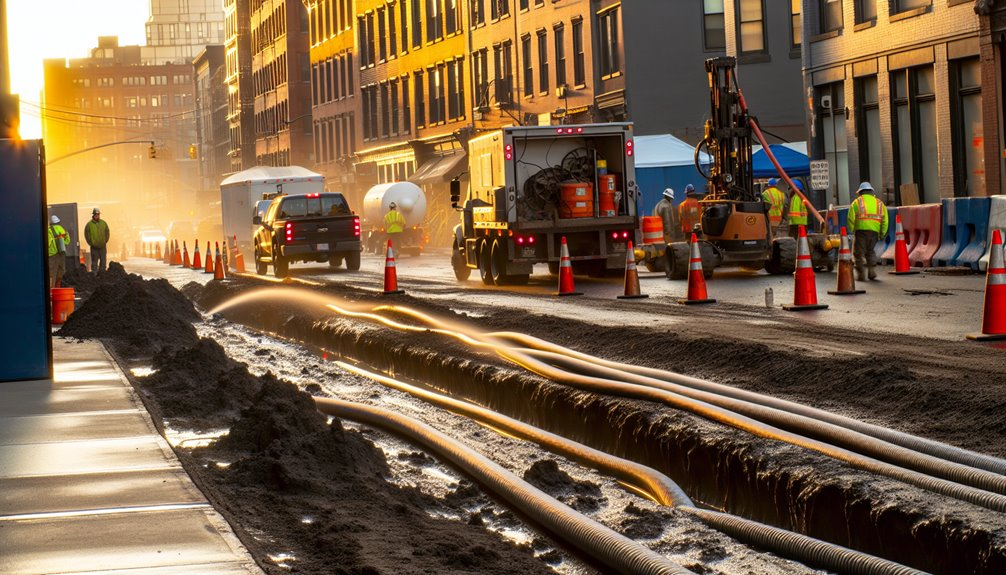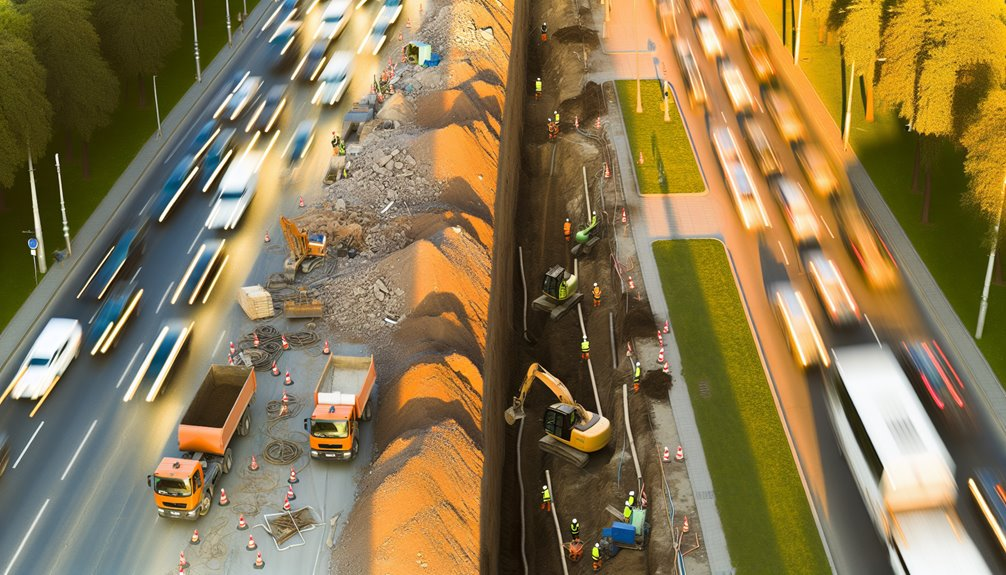In trenching services, you'll often face the challenge of accurately identifying underground utilities, a task complicated by inconsistent records and varied site conditions. Utilizing ground-penetrating radar (GPR) and GPS technology not only enhances detection but also minimizes the risk of damaging existing infrastructure. However, the integration of such technologies requires a steep learning curve and investment in advanced equipment. As you navigate these complexities, consider how leveraging these tools could revolutionize your approach to trenching, potentially transforming project outcomes and efficiency.
Identifying and Managing Underground Utilities
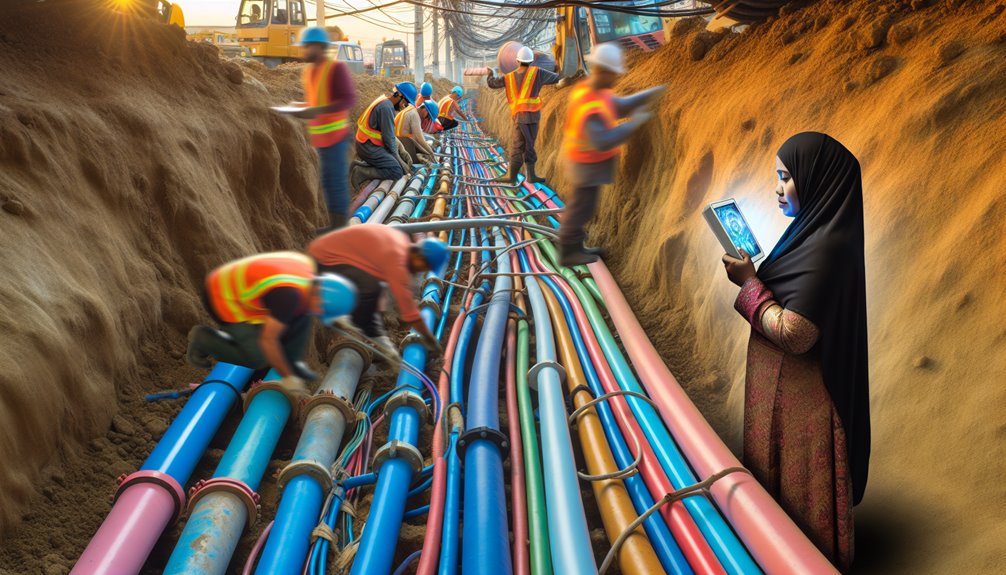
Identifying and managing underground utilities is essential before any trenching work begins.
You'll need to tackle outdated, often inaccurate utility mapping and documentation challenges head-on. Utilizing ground penetrating radar (GPR) and multi-frequency locators helps pinpoint the utilities' exact locations and depths, enhancing the accuracy of your risk assessments.
Coordinating with local utility companies for the most current maps and employing professional locating services can mitigate many of the risks associated with historical inaccuracies.
By integrating advanced 3D mapping technologies, you not only visualize but also strategize effectively, ensuring that every move is calculated and safety risks are minimized.
Always engage in thorough pre-excavation planning to prevent damage to these critical infrastructures. Implementing modern equipment such as vacuum excavation or hydro excavation also enhances precision and efficiency, aligning with the best practices for trenching and excavation needs.
Navigating Varying Soil Conditions
After addressing the complexities of locating underground utilities, another critical aspect to contemplate during trenching operations is the variability of soil conditions.
You must adapt to diverse soil types and moisture effects to guarantee stability and safety. Here's how:
- Assess Soil Type: Before excavation, conduct geotechnical evaluations to identify soil composition. Looser soils like sand may need different trenching approaches compared to denser clay.
- Monitor Moisture Content: Regularly check soil moisture levels. Increased moisture can dramatically destabilize soil, necessitating additional protective measures like shoring or trench boxes.
- Implement Mitigation Strategies: Use stabilization techniques such as shoring with metal plates or employing trench boxes to safeguard against cave-ins, especially in moisture-rich or loose soils. Understanding the soil conditions through detailed geotechnical reports can prevent project delays and ensure the correct mitigation strategies are used.
Adhering to Safety Regulations in Trenching Work
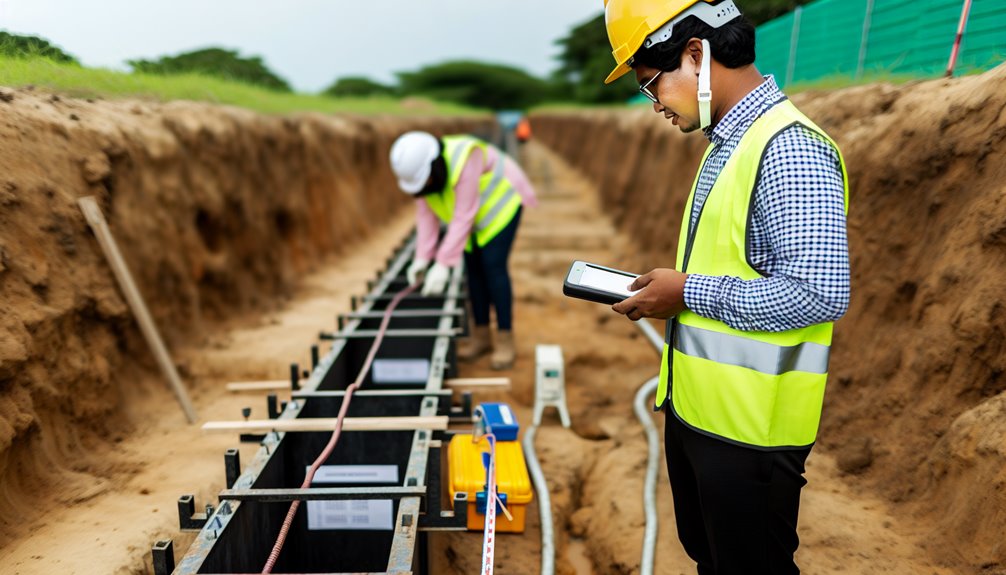
You must recognize potential hazards in trenching, including soil instability and water accumulation, before any work commences.
Training and certification are essential to guarantee all personnel are competent in identifying risks and implementing necessary safety measures.
In addition, strict adherence to equipment safety standards, such as maintaining a safe distance from trench edges, is vital to prevent accidents.
Identifying Potential Hazards
To guarantee safety during trenching operations, evaluating potential risks related to nearby structures and soil conditions is essential. You must be vigilant about the surrounding environment and the ground you're working with.
Here's how you can better identify potential risks:
- Conduct Daily Trench Inspections: Ascertain trench inspections occur daily and as conditions change. This proactive approach can prevent many accidents by identifying hazards early.
- Perform Thorough Soil Evaluations: Different soil types require different protective measures. Accurate soil evaluations help in choosing the right protection system, especially in trenches deeper than 5 feet.
- Monitor Weather Impact: Weather conditions considerably affect soil stability. Continuously assess the impact of weather on your trenching sites to adjust safety measures accordingly.
Training and Certification Essentials
While guaranteeing compliance with trenching safety regulations, it's essential that you as an employer provide thorough training and certification for all trenching personnel.
Your training methods must encompass a detailed understanding of hazard identification, the use of protective systems, and safe egress techniques. Verify that the certification processes validate the proficiency of workers in these critical areas.
Designating a competent person isn't just a regulatory formality; it's a pivotal role that demands deep knowledge of soil classification, hazard detection, and the design of protective systems.
This individual must also be equipped to conduct daily inspections and initiate corrective actions effectively. Their training should be continually updated to align with evolving safety standards and technological advances in trench safety.
Equipment Safety Compliance
Guaranteeing equipment safety compliance in trenching operations is paramount for preventing workplace accidents and fatalities. Your adherence to stringent safety regulations, focused on equipment maintenance and regular compliance audits, guarantees both operational efficiency and worker safety.
Here's what you need to focus on:
- Daily Inspections: Conduct thorough daily inspections of trenches and protective systems by a competent person, especially after any environmental changes, to identify and rectify potential hazards.
- Professional Engineer Oversight: For trenches 20 feet deep or greater, engage a registered professional engineer to design or approve your protective systems, guaranteeing they meet safety standards.
- Entry and Exit Safety: Maintain clear, safe entry and exit points, and position materials at least 2 feet from trench edges to prevent collapses and facilitate emergency responses.
Dealing With Weather-Related Disruptions
Dealing with weather-related disruptions in trenching operations poses significant challenges that affect both safety and productivity. You must prioritize weather preparedness and make seasonal adjustments to mitigate these risks.
In cases of heavy rain and flooding, installing robust drainage systems and utilizing heavy-duty pumps are essential to handle saturated soils and prevent machinery from becoming mired. Similarly, strong winds demand secure fastening of materials and careful monitoring of conditions to avoid accidents from flying debris or unstable equipment.
For extreme temperatures, adapting work schedules to milder times of day and providing appropriate climate control for both workers and machinery can safeguard against heat-induced malfunctions and cold-related inefficiencies.
Always integrate these strategies to maintain continuity in your trenching projects.
Ensuring Accurate Project Cost Estimation
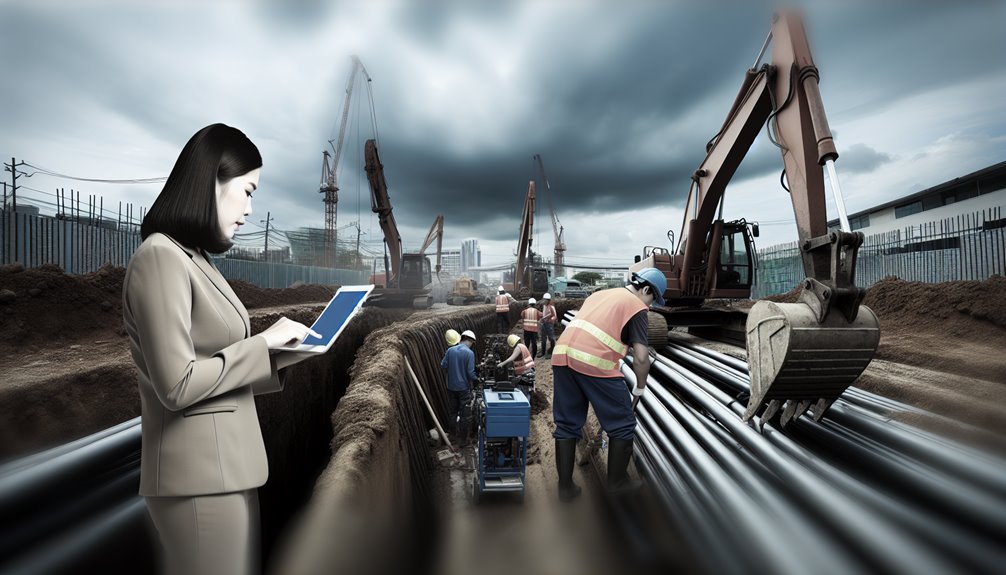
To accurately estimate the costs of your trenching project, it's essential to take into account a variety of factors that influence final expenses.
Here are key elements to evaluate for enhancing estimation accuracy and refining your cost breakdown:
- Unit Cost Estimation: Utilize unit pricing to ascertain the cost per cubic yard of excavation, adjusting for soil type and terrain complexity.
- Quantity Takeoff: Calculate precise material quantities from project plans, vital for budget adherence and avoiding resource shortages.
- Parametric Methods: Employ historical data and algorithms to predict costs based on project specifics like soil composition and excavation depth.
Integrating New Technologies for Improved Efficiency
As you integrate new technologies in trenching, adopting automated solutions can greatly enhance operational efficiency.
Automated trenching not only speeds up the process but also reduces human error and the physical strain on operators.
Additionally, integrating GPS mapping into your operations guarantees precise excavation and minimizes the risk of costly reworks or adjustments.
Adopting Automated Trenching Solutions
Integrating automated trenching solutions into your operations can greatly enhance efficiency and precision.
These advanced systems, specifically designed for trenching efficiency, leverage cutting-edge technologies to streamline excavation processes.
Here's how you'll benefit:
- Precision and Control: Automated systems like TrenchTronic offer millimeter-level accuracy in trench orientation and positioning, surpassing traditional methods.
- Productivity Gains: Achieve 2x to 4x the productivity of conventional rock breakers. These systems excavate in vertical layers, reducing rework and enhancing speed.
- Safety and Compliance: With features like anti-collision functions and real-time as-built drawings, you'll guarantee safer operations and compliance with regulations, minimizing the risk of errors.
Adopt these solutions to stay ahead in a competitive market, guaranteeing your projects aren't only efficient but also precise and safe.
Benefits of GPS Mapping
GPS mapping greatly enhances the accuracy and efficiency of trenching operations by providing precise locations of underground utilities. This integration reduces your risk of damaging critical infrastructure during excavation, ensuring safety and protecting property.
GPS advantages extend to detailed digital records, offering thorough, up-to-date mapping accuracy that surpasses traditional methods. This level of precision minimizes utility strikes and enhances asset management, allowing for efficient maintenance schedules and optimized resource allocation.
In addition, by relying on real-time data, you reduce errors and maintain consistency across projects. Overall, integrating GPS mapping into your trenching services not only streamlines workflows but also results in significant cost and time savings, reinforcing the value of adopting advanced technological solutions.
Conclusion
In summary, you must adeptly navigate the complexities of trenching services by leveraging advanced technologies like GPR and GPS for precise utility mapping. Evaluating soil conditions thoroughly and adhering strictly to safety regulations are non-negotiable to mitigate risks. Additionally, integrating automated solutions can greatly enhance your operational efficiency and accuracy, effectively reducing costs and project timelines. Stay proactive in adapting to these strategies to guarantee your trenching projects are both successful and compliant.
If you're looking to dive deeper into trenching services and discover how we can assist you, I warmly invite you to visit Boring Bros at boringbro.com. You can also reach out to us directly by calling (954) 639-6167. We're here to help, and we'd love to chat about your project needs!

